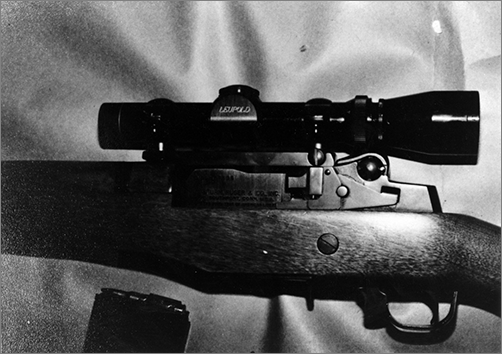What troopers knew as they took Robert Hansen in for interrogation was that stray brass had been found at gravesites on the Knik River, gravesites where the remains of missing dancers were found. The also knew that the brass was from a very specific group of firearms — ones like AR-15’s and Mini-14’s — that fired .223 caliber rounds. Troopers wanted to know more about Hansen’s weapons and where he’d fired them. If they could get him to place himself and his .223 on the Knik, they were one step closer to putting him away.
Bob, in his peculiar, half-bragging, half-dissembling style, led them down a garden path of meaningless evasions. One thing was certain: he fancied himself quite the expert with his .223. It was, it seemed, a natural extension of himself, his own, personal mini-me.

Hansen’s .223 “Mini-14” — His Preferred Murder Weapon (courtesy Alaska State Troopers)
“Under questioning Hansen said he had been up on the Knik that fall, duck hunting with his son. He also said he’d been there during the summer. Where had he fired his .223 during that time? Flothe asked. On a map, Hansen pointed to a big, flat territory to the west of the old Knik River bridge.
“There’s some islands here,” he said, pointing to the same spot. “Green islands in through here. I’ve gone on the banks there and shot into those banks along here many, many times. At some spots up there I’ve gone and put stuff in the river, you know, and flown over and tried to shoot at them to practice for wolf hunting…”
“Oh, you’ve shot from the air?” Flothe asked, only half believing.
“Yeah.”
“You’ve shot from the air,” Flothe said again, sardonically. “I didn’t realize you’ve done that. I have a more specific map of this area here. Hold it down. This is an aerial photograph. There’s a bunch of little numbers on here and I can—I can explain some things to you afterwards, but let’s do this in relation to the map you have in your hand now. Can you help me out?”
“By number three here?” Hansen said, pointing to the aerial map. “I’ve shot along these banks in here many times, because it’s a good place to shoot, because you’ve got some good flat banks in here.”
“Uh huh,” Flothe acknowledged.
“You can throw balloons in the water and when you shoot, you can see where your bullets are striking.”
“This is from the aircraft flying over?” Flothe asked, still dubious.
“Yes. In the wintertime, I shoot wolves an awful lot.”
“Describe your .223 to me,” Flothe said suddenly. “I am not over at the house now. Describe it to me.”
“Just a normal .223. The old—there’s only one model that I know of.”
“Well, there’s quite a few different models. There’s, you know, there’s M-16’s, which are fully automatic,” Flothe pointed out. “There’s AR-15’s…”
“Mini-14’s…” Galyan added.
“14,” Hansen responded, indicating that was the model he was familiar with.
“Okay, the Mini-14. And this is the one you’re talking about?” Flothe asked. “You practiced dry runs, like shooting wolves, is that what you’re talking about?”
“The reason I’m practicing here is to shoot wolves.”
“And you’ve hunted in that area?” Flothe asked.
“Oh, yes. Here. You can see this-here river here, how flat it is. We put balloons out there. If you hit one, of course, it bursts. If not, you can see.”
Both Flothe and Galyan had trouble suppressing their skepticism. Here was a man accused of murder, a man who now had to suspect that his shell casings were on the Knik, and he was trying to wriggle out of it by suggesting that he’d been up there shooting at balloons while flying a plane.
Excerpt From Butcher, Baker, Walter Gilmour & Leland E. Hale
Purchase Butcher, Baker